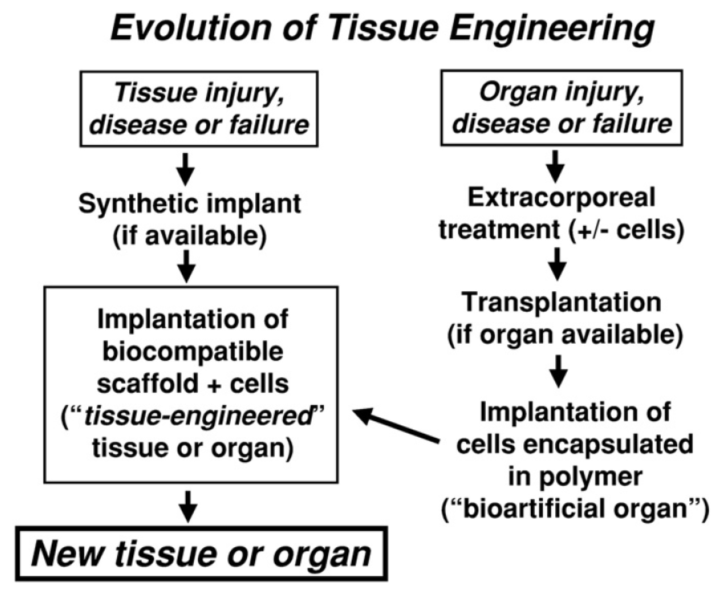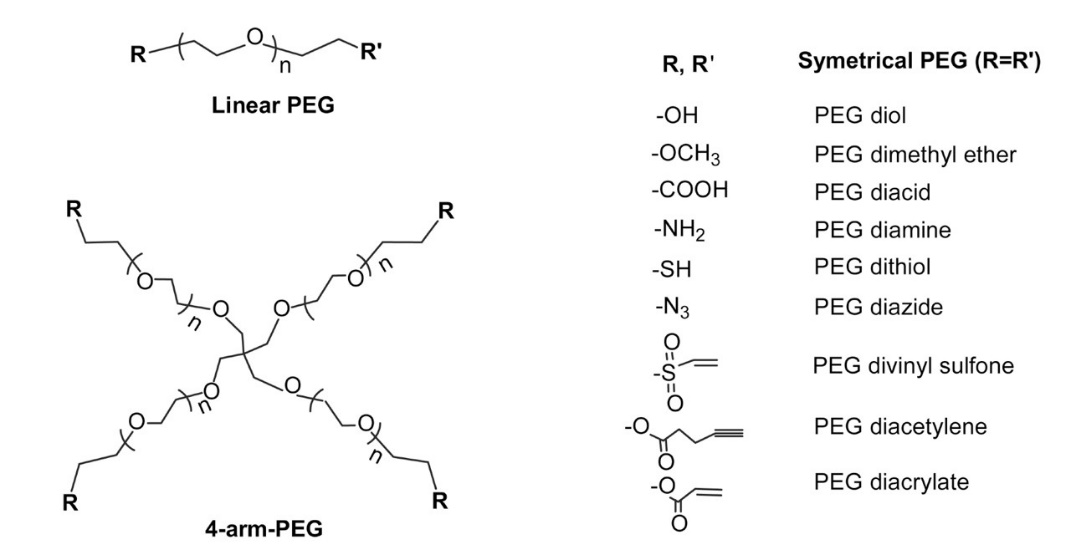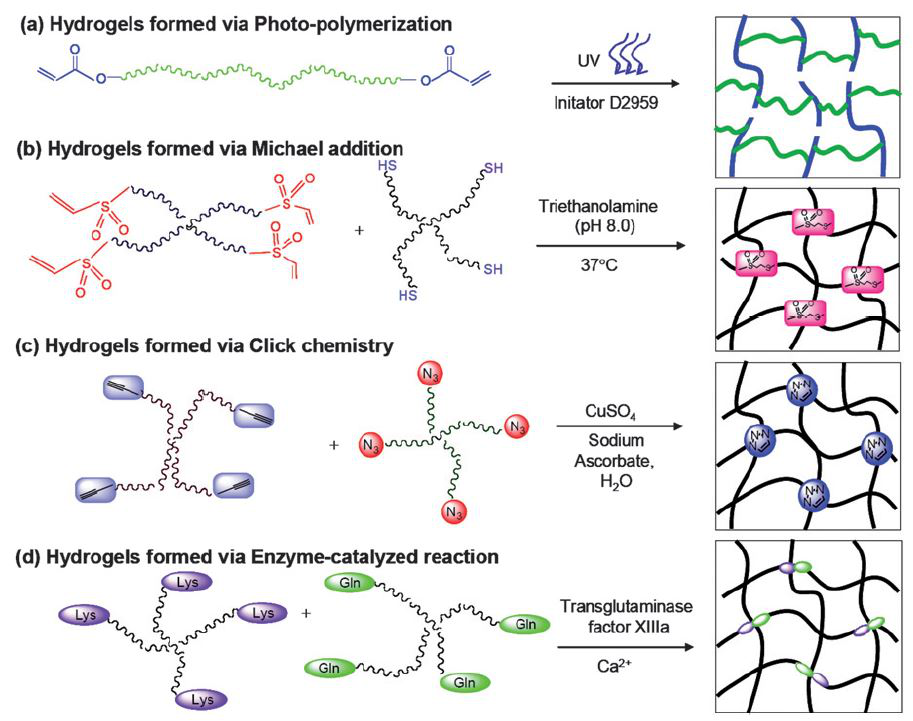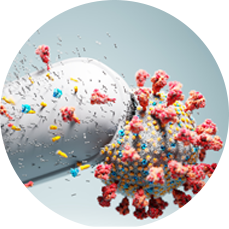PEG for Tissue Engineering
When parts or the whole of certain tissues or organs fail, there are several options for treatment, including repair, replacement with a synthetic or natural substitute, or regeneration. The fabrication of cell scaffold with hydrogel that derived from natural polymer materials is an attractive method to be applied for the tissue engineering, but some undesirable mechanical properties and immunogenic risks of natural hydrogel is a dilemma for this kind of application. However, PEG is a promising raw material for the biomaterials as well as for the tissue engineering.
 Fig 1. Schematic illustration of tissue engineering's evolution. (Advanced Drug Delivery Reviews 2012, 64, 18-23)
Fig 1. Schematic illustration of tissue engineering's evolution. (Advanced Drug Delivery Reviews 2012, 64, 18-23)
Advantages
There are several advantages of PEG as the raw materials for tissue engineering among other natural materials.
- Synthetic Versatility
PEG that synthesized via anionic polymerization of ethylene oxide, is a synthetic and non-biodegradable polymer that can be dissolved in water with any length. Therefore, the polymerization of PEG from ethylene oxide or ethylene glycol is easily controllable in aqueous solutions with quite narrow polydispersity. Linear PEG bears only two functional groups at the end of its chain, and commercial PEGs are available with different molecular weight and functionality. While multi-arms PEG derivatives can be prepared by ethoxylation of different cores such as pentaerythritol, hexaglycerol, or tripentaerythritol. With the versatility of PEG raw materials on the market, various PEG-based products can be manufactured for the tissue engineering applications.
 Fig 2. Structures of linear PEG and 4-arm-PEG with various functional end groups. (Biomaterials 2010:17;4639-4656)
Fig 2. Structures of linear PEG and 4-arm-PEG with various functional end groups. (Biomaterials 2010:17;4639-4656)
- Biocompatibility and Biodegradability
The biocompatibility of PEG was intensive investigated but many researchers, and all of them prove this result, and demonstrate the potential application as the cell scaffold in tissue engineering. While the PEG itself has the resistance to protein adsorption, which limits the biodegradation of PEG scaffold in tissue, the block copolymer of PEG with many biodegradable polymers, such as polylactic (PLA) and polycaprolactone (PCL), can yield a new generation of PEG copolymer that inherently possesses the biocompatibility and biodegradability. Moreover, the degradation degree can be controlled by choosing vast types of PEG copolymer.
 Fig 3. Chemical structures of PEG-PCL and PLA-PEG-PLA copolymers. (Macromolecular bioscience, 7(1), 23-39)
Fig 3. Chemical structures of PEG-PCL and PLA-PEG-PLA copolymers. (Macromolecular bioscience, 7(1), 23-39)
- Tunable Structure
In addition to its chemical composition, the mechanical properties of PEG-based scaffold can also be tuned. Stiffness, porosity, mechanical stability and elasticity are the properties that very crucial to evaluate the biomaterials as well as the cell scaffolds. These properties are largely correlated to the degree of crosslinking. Not only the length and the molecular weight of PEG can be manipulated during the synthesis procedures, but also the functionality of end groups can be chemically modified. At meanwhile, the types of active chemicals that react with PEG to fabricate the hydrogel or scaffold is variable. All these parameters are related to the crosslinking density that influences the mechanical properties. In order to be used as scaffold for tissue engineering applications, the material must provide an optimal niche for cell proliferation and differentiation, focused on cell attachment. Therefore, the modifications are used to tune this property. Overall, the tunable structure of PEG hydrogel endows assorted possibilities to it on the application of tissue engineering.
Preparation methods of PEG hydrogel for scaffold
 Fig 4. Reaction scheme for preparing PEG based hydrogels via (a) photo-polymerization; (b) Michael addition; (c) click chemistry; (d) enzyme catalyzed reaction. (Soft Matter 2010, 6 (1): 67-81)
Fig 4. Reaction scheme for preparing PEG based hydrogels via (a) photo-polymerization; (b) Michael addition; (c) click chemistry; (d) enzyme catalyzed reaction. (Soft Matter 2010, 6 (1): 67-81)
- Michael addition
The Michael addition is a facile reaction between nucleophiles and activated olefins and alkynes. The mild reaction condition, the rapid cure and high conversions under physiological environment are of great significance for biological applications such as the incorporation of bioactive macromolecules and cells.
- Click Chemistry
This click reaction is highly chemo-selective and can be performed under mild conditions in aqueous buffers with a wide range of pH, indicating high applicability for site-specific reaction, and generally results in a high yield of the desired product. The crosslinking in these hydrogels is extremely high, and results in a more ideal structure leading to improved properties when compared to traditional photochemically-crosslinked PEG hydrogels.
- Enzymatic Reaction
Most enzymes catalyze chemical reactions at low temperature, neutral pH, and in buffered aqueous solutions, mild conditions under which many conventional chemical reactions fail. Enzymes can also be exceptionally selective for their substrates, allowing for sophisticated, biologically inspired designs without the complication of side-reactions and cellular toxicity.
- Photopolymerization
The most common approach to make PEG hydrogels is photopolymerization, which utilizes light to convert liquid PEG macromer solutions into solid hydrogels at physiological temperature and pH. This method is advantageous for fabricating hydrogel scaffolds in situ with spatial and temporal control and in a variety of 3D structures with encapsulation of cells and biological agents. PEG acrylates are the major type of macromers used for photopolymerization, including PEG diacrylate (PEGDA), PEG dimethacrylate (PEGDMA), and multiarm PEG (n-PEG) acyrlate (n-PEG-Acr).
References
- Tessmar, J. K.; Göpferich, A. M., Customized PEG‐derived copolymers for tissue‐engineering applications. Macromolecular bioscience 2007, 7 (1), 23-39.
- Hoffman, A. S., Hydrogels for biomedical applications. Advanced Drug Delivery Reviews 2012, 64, 18-23.
Why BOC Sciences?
-
Large Stock
More than 2000+ products in inventory
-
Global Delivery
Warehouses in multiple cities to ensure fast delivery
-
mg to kg
Multi specification for academic research and industrial production
-
24/7 Technical Support
Strict process parameter control to ensure product quality
Technical Support
- Aqueous Two-Phase System (ATPS) Technique
- Capillary Electrophoresis (CE) Technique
- Enzyme-linked immunosorbent assay (ELISA) Technique
- High performance liquid chromatography (HPLC) Technique
- Hydrophobic Interaction Chromatography (HIC) Technique
- PEGylated Protein Purification Techniques
- Radiolabeling Technique
- SDS-PAGE Technique
- Ultrafiltration Technique
Products
- Lipids
- PEG Derivatives by Structure
-
PEG Derivatives by Functional Group
- Acrylate/Acrylamide/Methacrylate PEG
- Aldehyde (Ald/CHO)PEG
- Alkyne PEG
- Amino PEG, PEG amine(-NH2)
- Azide PEG, Azido PEG(-N3)
- Biotin PEG
- Boc/Fmoc protected amine PEG
- Carboxylic Acid(-COOH) PEG
- Cholesterol PEG
- DBCO PEG
- DNP PEG
- DSPE PEG
- Epoxide glycidyl ether PEG
- FITC PEG
- Folate PEG
- Halide (chloride, bromide) PEG
- Hydrazide PEG
- Hydroxyl(-OH) PEG
- Maleimide(-MAL) PEG
- NHS ester PEG
- Nitrophenyl carbonate (NPC) PEG
- Norbornene PEG
- Olefin/Alkene/Vinyl PEG
- Orthopyridyl disulfide (OPSS) PEG
- Phosphate PEG
- Rhodamine PEG
- SCM PEG
- Silane PEG
- SPDP PEG
- Sulfonate (tosyl, mesyl, tresyl) PEG
- tert-Butyl protected carboxylate PEG
- Thiol(-SH) PEG
- Vinylsulfone PEG
- PEG Copolymers
-
PEG Raw Materials
- Small-molecule Polyethylene Glycol
- Polyethylene Glycol 1000
- Polyethylene Glycol 10000
- Polyethylene Glycol 1500
- Polyethylene Glycol 200
- Polyethylene Glycol 2000
- Polyethylene Glycol 20000
- Polyethylene Glycol 400
- Polyethylene Glycol 4000
- Polyethylene Glycol 600
- Polyethylene Glycol 6000
- Polyethylene Glycol 800
- Polyethylene Glycol 8000
Resources
-
Technical Information
- Aqueous Two-Phase System (ATPS) Technique
- Capillary Electrophoresis (CE) Technique
- Enzyme-linked immunosorbent assay (ELISA) Technique
- High performance liquid chromatography (HPLC) Technique
- Hydrophobic Interaction Chromatography (HIC) Technique
- Introduction of Polyethylene Glycol (PEG)
- Ion Exchange Chromatography (IEX) Technique
- PEG for Chemical Synthesis
- PEG for Cosmetic Application
- PEG for Drug Delivery
- PEG for Imaging Diagnosis
- PEG for Pharmaceutical Preparation
- PEG for Tissue Engineering
- PEG Purification Techniques of Plasmid DNA
- PEGylated Protein Purification Techniques
- Radiolabeling Technique
- SDS-PAGE Technique
- Size Exclusion Chromatography (SEC) Technique
- Ultrafiltration Technique
-
Industry News
- Applications of PEG-DSPE: Drug Carriers and Drug Delivery
- Applications of Polyethylene Glycol (PEG) as Medical Devices
- Classification of Lipid-Based Vaccine Adjuvants
- FDA approved PEGylated Products
- How are Liposomes Different from Micelles?
- How Lipid Nanoparticles (LNPs) Deliver RNA Drugs?
- Hyaluronic Acid & PEGylated Hyaluronic Acid
- Ionizable Lipids for RNA Delivery
- Lipid Classification and Drug Delivery Systems
- Lipid-Drug Conjugates (LDCs) for Nanoparticle Drug Delivery
- Liposome in Drug Delivery
- Overview of Liposome Preparation Process
- PEG in Pharmaceutical Preparations (I): Solvents, Lubricants, Adhesives and More
- PEG in Pharmaceutical Preparations (II): Stabilizers, Plasticizers and Modification Materials
- PEG Linkers in Antibody Drug Conjugates and PROTACs
- PEG-DSPE Block Copolymers and Their Derivatives
- PEGylated RGD Peptides: A Promising Tool for Targeted Drug Delivery
- Polyethylene Glycol (PEG) Modified Targeting Nanomaterials
- Preparation Method of PEG Hydrogel
- The PROTAC Technology in Drug Development
- What are Biotinylation and Biotinylated PEG?
- What are Lipid Excipients and Their Applications?
- What are Lipid Nanoparticles and Their Applications?
- What are Lipid-Drug Conjugates (LDCs)?
- What are Lipids?
- What are Monodispersed and Polydispersed PEGs?
- What are PEG Lipids?
- What are Phospholipids?
- What is Click Chemistry?
- What is Hydrogel?
- What is Methoxy Polyethylene Glycol (mPEG)?
- What is Nanogels and Its Applications?
- What is the Formulation of Lipid Nanoparticles (LNPs)?
Our Feature
BOC Sciences supplies a unique variety of PEG derivatives and functional PEG polymers. Our products offer the most diverse collection of reactivity, ready-to-use functionality, and molecular weight options that you will not find anywhere else.

PEGylation of Peptides
and Proteins
Reduce the Immunogenicity of Peptide/Protein Drugs
Learn More
APPLICATIONS

PEG linkers For Drug
Improved Circulation Half-Life
Learn More
Have Customer Reviewed On Us?

Chat With Us






